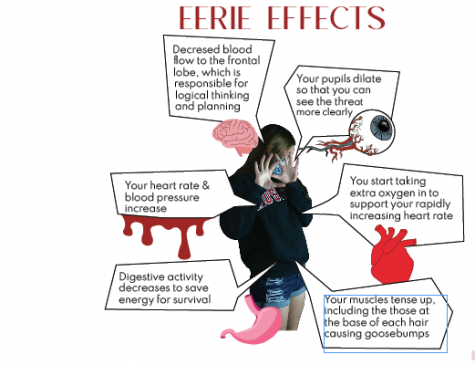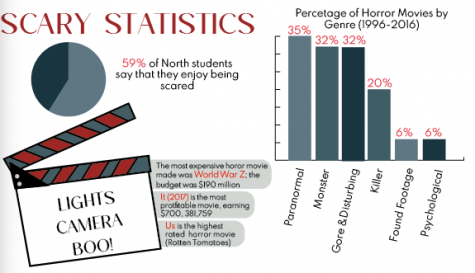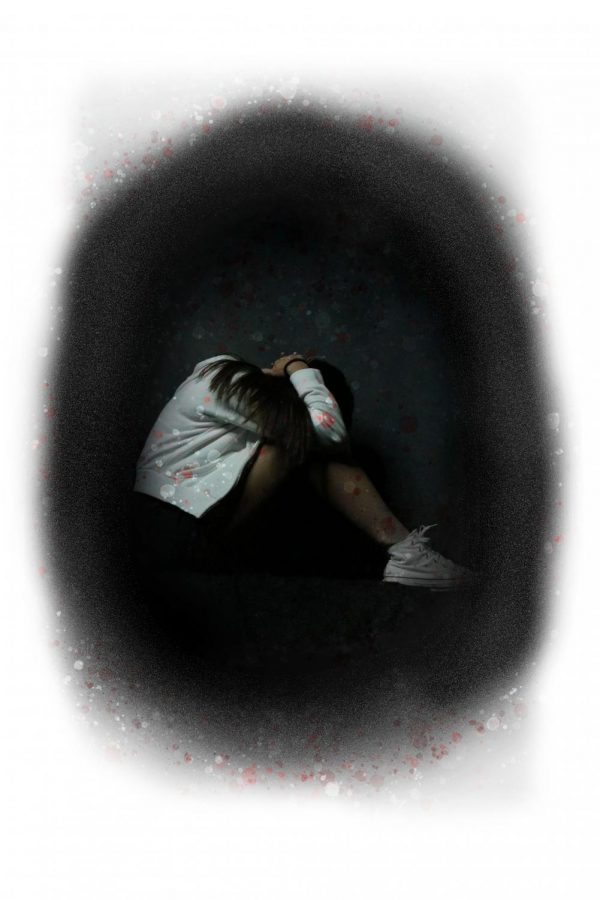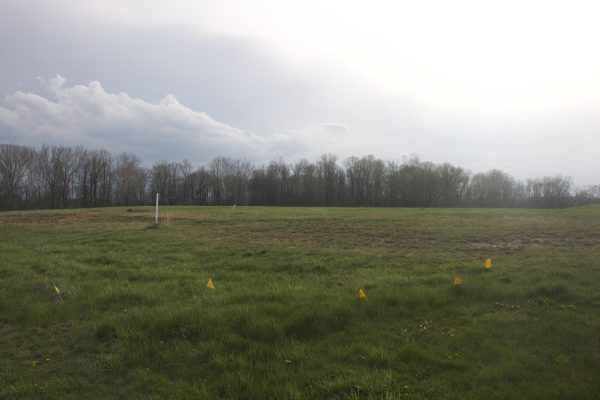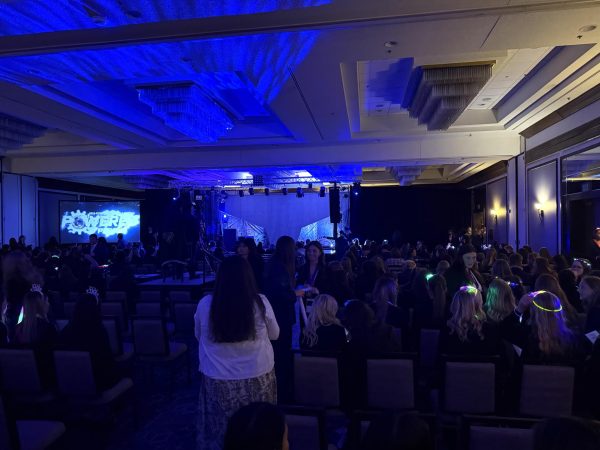Fear, Inc.
A look into why we enjoy being scared and what makes fear so sellable
October, the spookiest season. The air is chilled, the nights are long and haunted houses are open to visitors. An endless stream of horror movies sit waiting to be watched. People seek out the most outlandish Halloween costumes they can find. It’s a season to hunker down, to spend time getting in touch with your fears. But this atmosphere raises a question: why would a person enjoy being scared? And why are films and experiences designed for maximum fear so profitable?
In a poll on @cnhsmedia Instagram, more than half of students reported that they enjoy being scared. Among them is sophomore Kloie Douglas.
“I think I enjoy being scared because there’s somewhat of a rush to it. I enjoy other types of ‘thrills’ as well, mostly roller coasters,” Douglas said. “The feeling of being on a roller coaster and watching a horror movie or going to a haunted house are very similar to me. They both produce an intense feeling of happiness, somehow, even though I’m scared out of my mind.”
This might explain the popularity and volume of horror movies. Audiences seek them out for a thrill, especially around this time of year. Profit margins can be high. Take, for example, The Blair Witch Project, a 1999 found footage horror movie about a group of students investigating a mysterious serial killer. With a budget of only $600,000, the movie earned more than $248 million in the box office. It combined psychology and brilliant marketing to find this success. Other horror movies have enjoyed similar successes, as have experiences like haunted houses, both playing on the popularity of fear.
Of course, no matter how scary the movie, it needs to build up an audience. This can be done on many scales, from Super Bowl ad spots to online chat boards. These campaigns can be spookily effective.
Finding the way to get scary movies out to the public can be more of a strategizing task. It takes a lot more thought advertising and putting out movies than some may think. North marketing teacher Brian Campbell explains the process.
“I would say you’re going to want to find an audience,’’ Campbell said. “You want to find a target market that would pay to go see it, who’s going to enjoy it.”
A lot of factors can go into the target audience: it could be gender, generation, and simply different things people are interested in. Figuring that out can help scary movies get a bigger audience.
“I would say they play to the target markets, somebody who’s my age, over 50, I don’t want to be afraid of something,” Campbell said. “I enjoy seeing something fun and happy where a teenager or someone in their twenties thrives on.” Campbell said.
However, there are still plenty of middle aged people who enjoy scary movies and do watch them more than any other genre of movie. People have different interests and some change with age but some remain your whole life. Scary movies aren’t always heard of through advertisements but can be shared through talk.
“It’s going to spread through word of mouth how good the movie was, you’re looking for that group of people that will promote the movie through different social media or whatever the case may be so that they can find that target market,” Campbell said. “The movie kind of sells itself.”
Opinions on movies and other things are shared through talk and that can make someone want to watch a movie more than just an advertisement can. You usually trust the person telling you about the movie and that can be the same with directors and authors you’ve made a connection with.
“My favorite horror movie is probably House of 1000 Corpses. It was directed by Rob Zombie,” Douglas said. “I really like his style of directing and I think that his horror movies have been really good additions to the genre. It does help that I like his music as well.”
Scary movies can be shared in many ways and advertisers strategize the way to get the word out. They study the factors that go into who scary movie fans are.
“They prey upon people who want people to feel a passion for something,” Campbell said.
Marketing is crucial to the success of a movie, but so is human psychology. To many, it seems paradoxical that people get joy out of what should be an unsettling experience. Certainly, there are many students that chase the burst of adrenaline that accompanies fear; in a poll on @cnhsmedia Instagram, 70 percent of students said they consider themselves adrenaline chasers. Among them was sophomore Colby Lovins.
“I would say I’ve always been an adrenaline chaser to some extent. Since I was little I’ve always enjoyed roller coasters and other high energy experiences,” Lovins said.
Fear causes an array of physiological reactions: the release of adrenaline, of course, increased heart rate and activation of the fight-or-flight response. Still, for those who don’t like being scared, the pursuit of this response can be puzzling. AP Psychology teacher Richard Sluder offered some insight into this conundrum.
“The chemicals that make us scared and the chemicals that make us excited are really similar, and there are a lot of people that like that feeling,” Sluder said. “Scared/happy/scared/happy are pretty close. It’s all about how the body interprets [the event]. If you know that you’re safe — but scared – it’s enjoyable to a lot of people.”
It seems that our interpretation of events is a large part of what makes fear attractive. It’s unlikely that a person would enjoy being scared if their life was really in danger, for example. It’s all about the context the scary thing takes place in. Senior Sofia Martinez agreed.
“I am generally an anxious person and I will only seek that adrenaline rush when I know I’m 100 percent safe, like with haunted trails, or horror movies,” Martinez said.
But why are some people able to so easily immerse themselves in the world of a horror movie or forget that the masked people with chainsaws on a haunted trail are just actors? Again, the answer lies in the context. Movies use music and cinematography to keep audiences immersed in the story; haunted trails and houses use special effects and actors. According to Sluder, it’s common for people to lose themselves in a story by suspending their disbelief.
“That’s just a natural human characteristic I think, to want to be in the moment. You’re in the moment, everything’s exciting, and you’re not really paying attention to your surroundings anymore,” Sluder said. “It really kind of is like a mythical dreamy world you get to enjoy for a little while.”
People enjoy experiences that take them away from reality for a while, whether that’s scary movies, planning a killer Halloween party or even scaring others.
“Last year I volunteered to work in the CERAland haunted trail for the first time, and it was so fun being on the other side of it,” Lovins said. “I wore a Michael Myers mask and had a fake knife. I hid behind a bush and jumped out at all of the groups as they walked by. I plan on doing it again this year!”
Fortunately for fear fans, scary movies generally don’t have any long-lasting negative psychological effects. Even the most haunting of films tend to become not-so-scary after just a few weeks.
“It would be the type of thing that bothers you for a few days, maybe a week or so,” Sluder said. “You’d be scared for a while, maybe have a bad dream about it, get a little nervous about getting in a car or whatever it is, but eventually that would fade away. So it wouldn’t, or shouldn’t, lead to something like PTSD, but you could have a short term reaction to it for sure.”
Taking all of this into consideration, the popularity of scary experiences seems a little less mystifying. It’s a little bit easier to see how marketing, psychology, and a healthy dose of good, old-fashioned fear allows low budget movies to rake in massive profits. Its advertising campaign went far past normal efforts: stories were planted in local newspapers where the story took place, missing posters were created for the three main characters, and a website invited readers to investigate the Blair Witch themselves.
All of this created an air of mystery around the entire film. Fans turned out in droves, hoping the spooky, documentary-style movie would provide much-sought answers. Some audiences were convinced that the events shown in the movie were real (although a disclaimer in the credits invalidated this claim).
The style of the movie made it easy for audiences to identify with the characters — they were regular, down to earth students like them, not distant Hollywood stars. It was no-frills, absent of the stunning special effects typical of higher budget movies. Viewers lost themselves in the boundless Maryland forest alongside the protagonists. When they were done, they told their friends, who went to see it for themselves. It became one of the most profitable movies of all time.
Beyond horror movies, there’s an entire ecosystem of haunted houses, haunted trails, festivals like Fear Fair and even haunted hay rides to explore. Each provides a different level of terror to choose from, as senior Jonathan Peña said.
“The haunted house is a great experience if you’re looking to be scared often! The haunted trails are more relaxed, but they still get a scare out of you. I highly recommend them!” Peña said.
This Halloween season, whether students choose to celebrate by holding a horror movie marathon, going to a haunted house, trick-or-treating or just carving pumpkins, they can take refuge in knowing that a little bit of fear can be a positive thing.
“Fear is actually good for you,” Sluder said. “It teaches you to be fearful of certain situations and appreciate others.”
